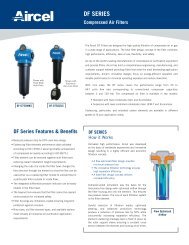Installation and Operation Manual - Aircel Compressed Air Dryer ...
Installation and Operation Manual - Aircel Compressed Air Dryer ...
Installation and Operation Manual - Aircel Compressed Air Dryer ...
Create successful ePaper yourself
Turn your PDF publications into a flip-book with our unique Google optimized e-Paper software.
<strong><strong>Air</strong>cel</strong> AHLD E-Series - Models 70 - 750<br />
Start-Up Procedure<br />
At any point during the process of startup or shutdown, you notice anything unusual; we recommend you<br />
refer to the operation manual immediately. If you cannot find the answer in the troubleshooting section,<br />
contact your <strong><strong>Air</strong>cel</strong> representative or the factory at once.<br />
14<br />
1. Ensure that the dryer is connected to a<br />
suitable compressed air supply. Make sure<br />
that the pressure of the supply is equal to<br />
the normal operating pressure of the dryer.<br />
2. Check to make sure the “shut-off’ valves<br />
are closed <strong>and</strong> that by-pass valve is open.<br />
3. Close all manual drain/vent valves.<br />
4. Slowly pressurize the dryer by gradually<br />
(slowly) opening the inlet shut-off valve to<br />
the OPEN position.<br />
5. When both towers of the dryer are<br />
completely pressurized, check the complete<br />
system for possible air leaks. Use soap<br />
<strong>and</strong> water to test all joints <strong>and</strong> fittings.<br />
If any leaks are detected, immediately<br />
depressurize the unit <strong>and</strong> correct the leaks.<br />
6. Make certain that any automatic<br />
condensate drain isolation valves are in<br />
the open position so proper condensate<br />
draining can occur.<br />
7. When normal operating pressure is<br />
reached, switch on electrical power (Turn<br />
switch to ON position)<br />
8. With by-pass valve closed, open the outlet<br />
valve slowly to allow air downstream.<br />
9. When energized one of the towers should<br />
depressurize.<br />
10. Check the operation of several cycles<br />
completely by following the control panel<br />
display screen operation, the panel lights<br />
on the electrical box, <strong>and</strong> the tower<br />
pressure gauges to make certain the dryer<br />
system is operating as displayed. Also<br />
refer to the how it works section, flow<br />
diagram, electrical drawing, dryer control<br />
display screen descriptions, <strong>and</strong> sequence of<br />
operation in this manual for reference.<br />
11. Check the drain valve for proper operation<br />
<strong>and</strong> discharge of liquid (filters <strong>and</strong><br />
separators, etc.).<br />
12. Near the dryer outlet (APV) valve, check<br />
the control air/ pilot air regulator secondary<br />
pressure, the regulator gauge should read<br />
100 psig. Increase or decrease regulator<br />
knob to achieve a 100 psig control air<br />
secondary pressure reading.<br />
13. Make certain the purge exhaust valves<br />
slowly open within an 8 to 12 second time<br />
period, some adjustment of the flow control<br />
valve attached to the actuator may be<br />
required, after adjustment tighten down the<br />
locking collar.<br />
14. Make certain a slight amount of air flow<br />
is felt at the end of the EMS RH sensor<br />
sample cell exhaust coil tube (this is<br />
normally located at the back of the dryer)<br />
adjust the needle valve to give more or less<br />
flow.<br />
15. Review the dryer system display screen<br />
shots (in this manual) to make certain<br />
the parameters are set as needed in the<br />
customer dryer.<br />
16. Purge air flow is preset <strong>and</strong> not adjustable.<br />
After the initial startup, the dryer operation is completely automatic. To underst<strong>and</strong> the details of the<br />
operation, we recommend you use the how it works section, flow diagram, electrical drawing, dryer control<br />
display screen descriptions, <strong>and</strong> sequence of operation in this manual for reference.



